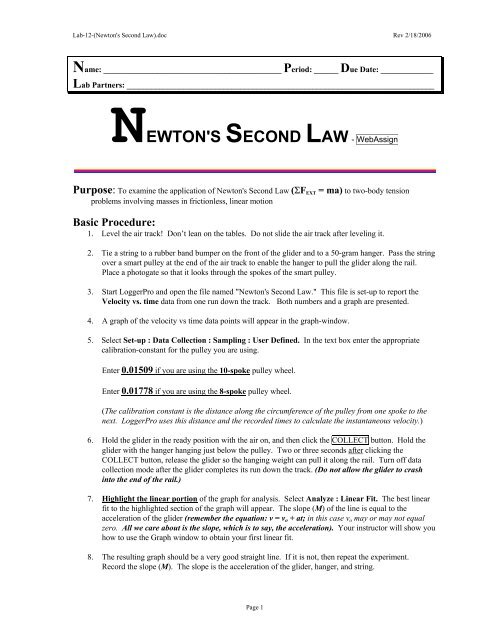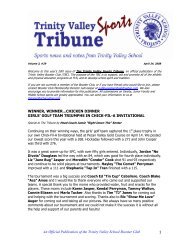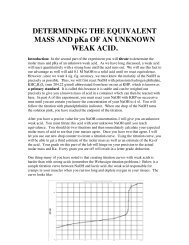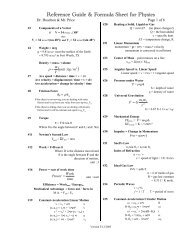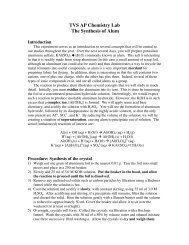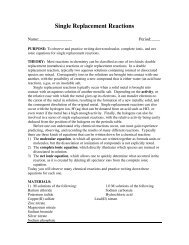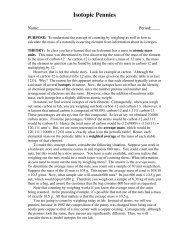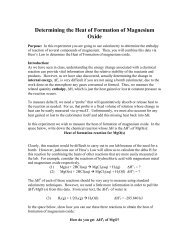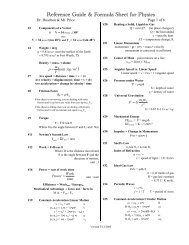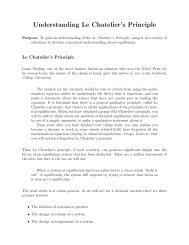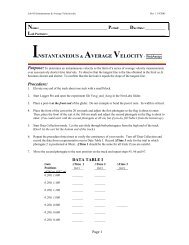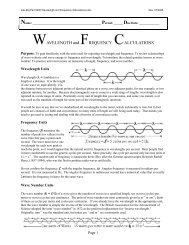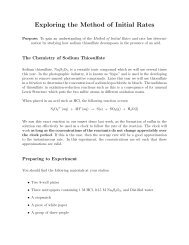Lab-12-(Newton's Second Law)
Lab-12-(Newton's Second Law)
Lab-12-(Newton's Second Law)
- No tags were found...
Create successful ePaper yourself
Turn your PDF publications into a flip-book with our unique Google optimized e-Paper software.
<strong>Lab</strong>-<strong>12</strong>-(<strong>Newton's</strong> <strong>Second</strong> <strong>Law</strong>).doc Rev 2/18/2006Name: ____________________________________________ Period: ______ Due Date: _____________<strong>Lab</strong> Partn ers: ____________________________________________________________________________NEWTON'S SECOND LAW - WebAssignPurpose: To examine the application of <strong>Newton's</strong> <strong>Second</strong> <strong>Law</strong> (ΣF EXT = ma) to two-body tensionproblems involving masses in frictionless, linear motionBasic Procedure:1. Level the air track! Don’t lean on the tables. Do not slide the air track after leveling it.2. Tie a string to a rubber band bumper on the front of the glider and to a 50-gram hanger. Pass the stringover a smart pulley at the end of the air track to enable the hanger to pull the glider along the rail.Place a photogate so that it looks through the spokes of the smart pulley.3. Start LoggerPro and open the file named "<strong>Newton's</strong> <strong>Second</strong> <strong>Law</strong>." This file is set-up to report theVelocity vs. time data from one run down the track. Both numbers and a graph are presented.4. A graph of the velocity vs time data points will appear in the graph-window.5. Select Set-up : Data Collection : Sampling : User Defined. In the text box enter the appropriatecalibration-constant for the pulley you are using.Enter 0.01509 if you are using the 10-spoke pulley wheel.Enter 0.01778 if you are using the 8-spoke pulley wheel.(The calibration constant is the distance along the circumference of the pulley from one spoke to thenext. LoggerPro uses this distance and the recorded times to calculate the instantaneous velocity.)6. Hold the glider in the ready position with the air on, and then click the COLLECT button. Hold theglider with the hanger hanging just below the pulley. Two or three seconds after clicking theCOLLECT button, release the glider so the hanging weight can pull it along the rail. Turn off datacollection mode after the glider completes its run down the track. (Do not allow the glider to crashinto the end of the rail.)7. Highlight the linear portion of the graph for analysis. Select Analyze : Linear Fit. The best linearfit to the highlighted section of the graph will appear. The slope (M) of the line is equal to theacceleration of the glider (remember the equation: v = v o + at; in this case v o may or may not equalzero. All we care about is the slope, which is to say, the acceleration). Your instructor will show youhow to use the Graph window to obtain your first linear fit.8. The resulting graph should be a very good straight line. If it is not, then repeat the experiment.Record the slope (M). The slope is the acceleration of the glider, hanger, and string.Page 1
<strong>Lab</strong>-<strong>12</strong>-(<strong>Newton's</strong> <strong>Second</strong> <strong>Law</strong>).doc Rev 2/18/20069. Part I & Data Table I: Changing the Mass of the GliderRepeat the basic procedure for these three trials.Use the 50-gram hanger with NO added weights in all three trials.Trial #1 - Use the glider with NO added weights,Trial #2 - Use the glider with 100 grams added (2 disk weights), andTrial #3 - Use the glider with 200 grams added (four disk weights).DATA TABLE IMass of hanger = ___________ kgMass of glider = ___________ kgMass of 2 disk weights = ___________ kgMass of 4 disk weights = ___________ kgSee Analysis Section for instructions. .Trial # Mass of MeasuredGlider & AccelerationWeights of Glider &(kg)Weights(m/sec 2 )1 __________ ___________2 __________ ___________3 __________ ___________Predicted %Error Tension inAccelerationString (N)of Glider &(from measuredWeightsacceleration)(m/sec 2 )__________ __________ ____________________ __________ ____________________ __________ __________Do not attempt the calculations in the right-hand box during the lab. The analysis section will explain what todo and how to do it. While you are in the lab, spend your time gathering the data. The calculations can be doneoutside of the lab, the measurements cannot.You must return in the next day or two to repeat any run for which the %Error exceeds 10%. Don’tdelay doing the calculations because the apparatus is going to disappear into storage very soon.Page 2
<strong>Lab</strong>-<strong>12</strong>-(<strong>Newton's</strong> <strong>Second</strong> <strong>Law</strong>).doc Rev 2/18/200610. Part II & Data Table II: Increasing Hanger WeightRepeat the same basic procedure for these five trials.Keep the glider fully loaded with all 4 disk weights in all five trials.Varying the mass on the hanger by adding 10 grams to each successive trial.Trial #1: Use the hanger with 10 grams added; Mass of Hanger & Weights = 60 grams,Trial #2: Use the hanger with 20 grams added; Mass of Hanger & Weights = 70 grams,Trial #3: Use the hanger with 30 grams added; Mass of Hanger & Weights = 80 grams,Trial #4: Use the hanger with 40 grams added; Mass of Hanger & Weights = 90 grams,Trial #5: Use the hanger with 50 grams added; Mass of Hanger & Weights = 100 grams.You don’t need to run the hanger without added weights because you’ve already run the fully loadedglider with the 50-gram hanger in Trial #3 of Part I).DATA TABLE IIMass of glider + 4 disk weights = ___________ kgSee Analysis Section for instructions. .Trial # Mass of MeasuredHanger & AccelerationWeights of Glider(kg) (m/sec 2 )1 __________ ___________2 __________ ___________3 __________ ___________4 __________ ___________5 __________ ___________Predicted %Error Tension inAccelerationString (N)of Glider(from measured(m/sec 2 )acceleration)__________ __________ ____________________ __________ ____________________ __________ ____________________ __________ ____________________ __________ __________Do not attempt the calculations in the right-hand box during the lab. The analysis section will explain whatto do and how to do it. While you are in the lab, spend your time gathering the data. The calculations canbe done outside of the lab, the measurements cannot.You must return in the next day or two to repeat any run for which the %Error exceeds 10%. Don’tdelay doing the calculations because the apparatus is going to disappear into storage very soon.Page 3
<strong>Lab</strong>-<strong>12</strong>-(<strong>Newton's</strong> <strong>Second</strong> <strong>Law</strong>).doc Rev 2/18/200611. Part III & Data Table III: Changing Angle of InclinationTake the all weights off both the glider and the hanger.Repeat the same basic procedure for these five trials.Before you begin, estimate the height of one book, by measuring the height of 10 identical books in astack. (These are the thin paperback books available in the lab cabinet.) Press down hard on thestack of ten before you measure its thickness. This squeezes out the air and flattens the pages.Divide by 10 to get the average thickness of one book.Elevate the pulley-end of the track using books from your stack. Vary the number of books in thestack with each trial.Trial #1: Use 2 books to elevate the rail. The glider and the hanger have NO added weights,Trial #2: Use 4 books to elevate the rail. The glider and the hanger have NO added weights,Trial #3: Use 6 books to elevate the rail. The glider and the hanger have NO added weights,Trial #4: Use 8 books to elevate the rail. The glider and the hanger have NO added weights,Trial #5: Use 10 books to elevate the rail. The glider and the hanger have NO added weights,DATA TABLE IIIMass of empty glider = ___________ kgMass of empty hanger = ___________ kgThickness of ten books = ___________ mThickness of one book = ___________ mSee Analysis Section for instructions. .Trial # Height of Measured(# of Books) Books Acceleration(m)of Glider(m/sec 2 )1. ( 2 ) _________ ___________2 ( 4 ) _________ ___________3. ( 6 ) __________ ___________4. ( 8 ) __________ ___________5. ( 10 ) __________ ___________Predicted %Error Tension inAccelerationString (N)of Glider(from measured(m/sec 2 )acceleration)__________ __________ ____________________ __________ ____________________ __________ ____________________ __________ ____________________ __________ __________Do not attempt the calculations in the right-hand box during the lab. The analysis section will explain whatto do and how to do it. While you are in the lab, spend your time gathering the data. The calculations canbe done outside of the lab, the measurements cannot.You must return in the next day or two to repeat any run for which the %Error exceeds 10%. Don’tdelay doing the calculations because the apparatus is going to disappear into storage very soon.Page 4
<strong>Lab</strong>-<strong>12</strong>-(<strong>Newton's</strong> <strong>Second</strong> <strong>Law</strong>).doc Rev 2/18/2006Analysis:[You must show Sample Calculations on page 7; clearly show the algebraic method and the numerical outcomefor each calculation used to analyze Trial #1 in each of the three data tables.]Parts I and IIPredict the acceleration of the glider using Equation 1.Calculate the tension in the string using the measured acceleration and Equation II.Enter the predicted accelerations and the calculated tensions in Data Table I & Data Table II.Calculate, as percent error, the difference between measured and predicted accelerations. Assume the predictedacceleration is correct. Enter the percent error between measured and predicted accelerations in Tables I & II.Equation IM is the mass of the glider.m is the mass of the hanger.(use g = +9.81 m/s 2 , since I’veassumed that right and downare the positive directions inderiving these expressions.)Equation II|T calc | is the magnitude of thetension in the string. On ourforce diagram. T points in bothnegative and positive directions.mg = (M + m) a predicted|T calc | = m(g − a measured )The acceleration ispositive (+).On the diagram below draw the force diagram showing all the forces acting on each mass. Do notinclude the weight of the string or the pulley. The diagram should show five force vectors when completed.Page 5
<strong>Lab</strong>-<strong>12</strong>-(<strong>Newton's</strong> <strong>Second</strong> <strong>Law</strong>).doc Rev 2/18/2006Part IIIThe sine of the inclination angle equals the “Height of Books” in meters divided by the distance between thelegs of the air track (which happens to equal 1.0000 meter). (Recall that sin θ = opp/hyp.)Predict the acceleration of the glider using Equation III.Calculate the tension in the string using the measured acceleration and Equation IV.Enter the predicted accelerations and the calculated tensions in Data Table III.Calculate, as percent error, the difference between measured and predicted accelerations. Assume the predictedacceleration is correct. Enter the percent error between measured and predicted accelerations in Tables III.Equation III(use g = +9.81 m/s 2 ,since I’ve assumed thatup the slope anddownward are thepositive directions inderiving theseexpressions.)Equation IV|T calc | is the magnitudeof the tension in thestring. On our forcediagram. T points inboth negative andpositive directions.mg − Mg sinθ = (M + m) a predicted|T calc | = m (g − a measured )The acceleration is positive (+).On the diagram below draw the force diagram showing all the forces acting on each mass. Show thetwo components of the weight of mass M. Do not include the weight of the string or the pulley. The diagramshould show five force vectors, plus the two relevant components of Mg, when completed.Page 6
<strong>Lab</strong>-<strong>12</strong>-(<strong>Newton's</strong> <strong>Second</strong> <strong>Law</strong>).doc Rev 2/18/2006Sample Calculations: See top of page 5 for instructions. Show all the calculations for the first trialin each data set. These should be neat and well organized.Page 7
<strong>Lab</strong>-<strong>12</strong>-(<strong>Newton's</strong> <strong>Second</strong> <strong>Law</strong>).doc Rev 2/18/2006Answer these Experimental Questions: (Answer #1 - #6 after you finish the sample calculations.)1a. Rearrange Equation I and solve for g. Now, use the measured acceleration, NOT the predictedacceleration, the known masses and your equation for g to estimate the local value of g from the data ineach trial in Parts I & II.g = _____________________________________Estimate of g --- from Trial #1 in Table I) = ___________________________ m/s 2Estimate of g --- from Trial #2 in Table I) = ___________________________ m/s 2Estimate of g --- from Trial #3 in Table I) = ___________________________ m/s 2Estimate of g --- from Trial #1 in Table II) = __________________________ m/s 2Estimate of g --- from Trial #2 in Table II) = __________________________ m/s 2Estimate of g --- from Trial #3 in Table II) = __________________________ m/s 2Estimate of g --- from Trial #4 in Table II) = __________________________ m/s 2Estimate of g --- from Trial #5 in Table II) = __________________________ m/s 21b. Rearrange Equation III and solve for g. Now, use the measured acceleration, NOT of the predictedacceleration, the known masses and your equation for g to estimate the local value of g from the data ineach trial in Parts III.g = _____________________________________Estimate of g --- from Trial #1 in Table III) = ___________________________ m/s 2Estimate of g --- from Trial #2 in Table III) = ___________________________ m/s 2Estimate of g --- from Trial #3 in Table III) = ___________________________ m/s 2Estimate of g --- from Trial #4 in Table III) = ___________________________ m/s 2Estimate of g --- from Trial #5 in Table III) = ___________________________ m/s 2Page 8
<strong>Lab</strong>-<strong>12</strong>-(<strong>Newton's</strong> <strong>Second</strong> <strong>Law</strong>).doc Rev 2/18/20061c. Suppose, in Part I, that you made the glider lighter and lighter. What is the maximum possible value of theacceleration? In other words, what is the maximum theoretical acceleration in the limit as the mass ofthe glider approaches zero? (The mass of the hanger is always greater than zero.)a (MAX) = ___ = ___________ m/s 21d. Suppose you could tilt the rail to any angle between –90º and +90º, where 0º is horizontal. At whatangle(s) will |a| = |g|? (Let +90º indicate that the pulley is high, and –90º indicate that the pulley is low.)2. If we did all these experiments again on Mars, what specific differences would you expect to observe?(|g Mars | = 3.8 m/s 2 .)3. If m = 2.0 kg and M = 9.0 kg, what elevation angle θ will give you an acceleration of zero?θ balance = ________º (3SF)4. If you switch the masses in question #3, can you get an acceleration of zero by tilting the track?Circle one answer and explain why or why not.YES or NO__________________________________________________________________________________________________________________________________________________________________________________________________________________5. If m = 2.0 kg and M = 9.0 kg, and if the track is level, what minimum value of the coefficient of staticfriction will ensure that the glider does not move; i.e. that the acceleration will be zero?µ S = __________ (3SF)6. The true local value of g at this school is ___________ m/s 2 .Find the average value of your estimates of g made in questions 1a. and 1b. above.Average value of g = __________________________ m/s 2Calculate the percent error between the true local value of g and your average estimate of g.%Error (in estimates of g) = __________________________Page 9
<strong>Lab</strong>-<strong>12</strong>-(<strong>Newton's</strong> <strong>Second</strong> <strong>Law</strong>).doc Rev 2/18/2006Two Hypothetical Problems − Think first.First Hypothetical ProblemIn this lab we elevated the rail at the end with the pulley. Suppose we could elevate either end of the rail.Create a graph (call it Graph 1) showing how you expect the measured acceleration to vary as a function ofelevation angle across a range of angles from –90º to +90º, where horizontal means a tilt of 0º. This graphof Acceleration vs Inclination Angle must show the calculated acceleration every 10º from −90º and +90º,inclusive. Assume that the glider and hanger both have masses of 0.400 kg. Thus, M = m = 0.400 kg.(The calculated acceleration must be zero when the angle is +90º and the acceleration must be –9.81 m/s 2when the angle is –90º. This result ASSUMES that when the angle is positive, the pulley end is high andthat when the angle is negative, the pulley end is low. Make sure your graph is consistent with thisassumption.)Page 10
<strong>Lab</strong>-<strong>12</strong>-(<strong>Newton's</strong> <strong>Second</strong> <strong>Law</strong>).doc Rev 2/18/2006<strong>Second</strong> Hypothetical QuestionAristotle (384 - 322 BCE) said that heavier objects fall faster than lighter objects. This erroneousconclusion was taken as fact for almost 2000 years until Galileo (1564 - 1642 CE) finally decided to try anexperiment. Newton (1643-1727) and the rest of us owe a debt of gratitude to Galileo for providing thisinsight and for pointing out the primacy of experimental evidence over mere logic and imagination,however well informed. Aristotle thought he was using logic alone, but all he did was convince himselfthat his original assumption was correct. Today we expect substantive data to provide the foundation ofany conclusions drawn about the behavior of natural and man-made systems. Indeed, scientists gather datadaily about how the universe itself works. There appears to be no physical system beyond the reach of thescientific method, which relies on measurable, rather than merely logical, evidence.Try to imagine what the world would be like if Aristotle had been correct.In the world of imagination, what Aristotle meant to say (in modern terms) about freely falling bodies mayhave been something like that shown in the box. We imagine that the Earth "creates" thei = w M “Motivation”, M, let’s call it, which acts on the weight, w, to force a body to move withconstant velocity i. Aristotle did understand that the velocity could change during whathe called unnatural motion, such as a cart being pushed. Objects seeking their natural position, such as afalling object, moved at their natural speed. He assumed dropped objects went from zero to their finalvelocity, instantaneously. Aristotle further claimed that heavier objects have a larger natural velocity thanlighter objects. The kindest way to put this is to say that Aristotle made a guess and was wrong. The lesskind view of Aristotle, is to say that he was too arrogant to take the time to examine the situation as closelyas it deserves. In any event his comments are vague and non-quantitative.He did not ask enough questions: How did he miss the obvious acceleration of falling objects? What if themotivation is not a constant? He did consider air resistance, but he got that wrong, too. Examining theseand other questions would have led him, eventually, to a position where he had to try an experiment. Thereare no obvious answers to be found by merely thinking about what “should” happen. Logic alone is notpowerful enough to understand the universe. It’s amazing that his immense curiosity did not eventuallydrive him outside to watch a few rocks fall.If Aristotle had discovered the value of doing experiments 2000 years before Galileo, we would live in avery different world today. With two additional millennia of technology under our belts, there is no tellingwhat our world would be like or where in the universe we might be exploring today.Assume for the purposes of this mini-section that Aristotle was right; that the Earth produces a constant“Motivation” that compels each object to move with a fixed velocity according to its weight. Note thatthere is no quantity in physics today comparable to M. Note, too, that there is no quantity in physics todaycomparable to i, the fixed universal velocity of a falling object. (Our velocities change with time and ouraccelerations change with distance from the center of the Earth or the nearest large body.)What are the units of “Motivation” in this hypothetical situation (assuming velocity is still measured in m/sand weight is still measured in something we can call a newton, N)?Aristotle’s units of Motivation (in units of m, s, and N) = ____________________If we consider dropped objects only, today, we expect the velocity at time t to be v = at = gt. The units ofvelocity are m/s. Recall that g has units of m/s 2 or N/kg. Therefore, we can also express velocity in unitsof N·s/kg. This is a problem for Aristotle since he only discusses weight and never discusses the differentand more fundamental quantity called mass. It is part and parcel with his overall ignorance about how thereal world works that he did not entertain the possibility of such a quantity as mass, distinct from weight.Explain the difference between mass and weight. ________________________________________________________________________________________________________________________Page 11
<strong>Lab</strong>-<strong>12</strong>-(<strong>Newton's</strong> <strong>Second</strong> <strong>Law</strong>).doc Rev 2/18/2006Aristotle believed, perhaps it was an article of faith, that the universe was capable of rationalunderstanding. That much seems to be universally accepted even today. His mistake was believing theuniverse could be understood using rational thought alone. We now understand, thanks in part to Galileo’searly efforts, that the rational thought experiment can be supported or refuted only through carefullycontrolled experiments, thorough observations, and logical interpretations of the data.Galileo loved to impress his wealthy patrons, and score points for the new science, by conductingdemonstrations in the form of experiments. One of his larger ones involved letting a brass ball roll down along incline. He was interested in studying the acceleration of the ball as it rolled down the slope. Doesthis sound at all familiar? When he actually did this experiment for himself he used a water clock tomeasure the times, but in his demonstrations he used bells to sound the times.Suppose that you have a 10-meter board and a metal ball to roll down it. Image three bells arranged so thatthe ball brushes up against each of them in turn as it passes, but is not slowed in its acceleration. Place thefirst bell at the top, the second 1/4 th of the way down, and the third bell at the bottom. This produces twotime differences: t 1-2 , and t 2-3.Because the distance traveled increases as the time squared, when acceleration is constant, we and Galileoexpect that the time used to move 1/4 th of the way down the hill will be half the time it takes to move all theway to the bottom of the slope. In other words, if you double the time you quadruple the distance covered.2· t 1-2 = t 1-2 + t 2-3 therefore t 1-2 = t 2-3Now, suppose that we, or Galileo, place 11 evenly spaced bells along the track, with the first at the top andthe eleventh at the bottom. Describe how the timing of the bells changes as the ball rolls down the slope.(The ball rolls silently except when it brushes against the bells.)_______________________________________________________________________________________________________________________________________________________________________________________________________________________________________________________________If Aristotle had tried, or even tried to imagine, as you have, an experiment like this, he would have beenimmediately confronted with the evident fact that velocities are not constant even for objects moving intheir natural direction. For velocity to be constant, the bells would have to ring at equal time intervals, butthey don’t.Galileo performed this experiment as a demonstration just to as simply and emphatically as he could thatAristotle got it wrong. Galileo’s rejection of Aristotle’s non-experimental method, and his advocacy ofexperiments as the ultimate judge of the worth of a theory, lead to the beginnings of the ScientificRevolution, which lead to the Industrial Revolution, which lead to our current technological revolution.How did Aristotle, by all accounts a very bright guy, get it so wrong? To answer that question, write ashort sentence or two about what Aristotle should have attempted, but never did._________________________________________________________________________________________________________________________________________________________________________________________________________________________________________________________________________________________________________________________________________________________________________________________________________________________________________Page <strong>12</strong>


